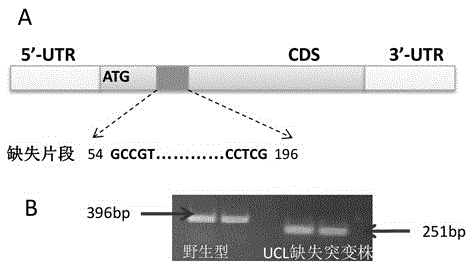Application of gene miR408 and UCL in cultivating high-yielding rice
A technology for transgenic rice and paddy rice, applied in the field of application in cultivating high-yielding rice
- Summary
- Abstract
- Description
- Claims
- Application Information
AI Technical Summary
Problems solved by technology
Method used
Image
Examples
Embodiment 1
[0090] Embodiment 1 rice total RNA extraction method
[0091] In the following examples of the present invention, the phenol-chloroform-isoamyl alcohol method is used to extract rice total RNA (including wild-type and various mutant rice), and the specific steps are as follows:
[0092] (1) Weigh 1g of rice sample and grind it into fine powder with liquid nitrogen, add 10mL RNAzol (100ml contains 47.2g of guanidine isothiocyanate, 2.5ml of 1M sodium citrate (pH7.0), 5ml of 10% sodium lauroyl anitrate) and 1mL sodium acetate (2M, pH4.0), continue grinding;
[0093] (2) Add 10mL of water-saturated phenol, 4mL of chloroform: isoamyl alcohol (49:1, volume ratio) mixture, mix well, transfer to a centrifuge tube, vortex for 1min, place on ice for 5 minutes, then 4°C, Centrifuge at 12000rpm for 15min;
[0094] (3) Take the supernatant after centrifugation, and add an equal volume of phenol:chloroform:isoamyl alcohol (50:49:1, volume ratio) mixture to the supernatant, vortex for 1...
Embodiment 2
[0102] Example 2 Construction of rice mutants overexpressing miR408
[0103] 1. Construction of MiR408 constitutive expression plasmid
[0104] (1) In this example, the vector pCAMBIA1390 (commercially available) was selected, and at the restriction site of the vector Hind III and Sal The CaMV35S promoter was inserted between I, which can be used as a constitutive promoter to control the expression of miR408 in the future. The experimental operation here adopts the routine technique in this field.
[0105] (2) Using the total RNA of the wild-type rice treatment sample extracted by the method in Example 1 as a template, the miR408 gene was cloned. The nucleotide sequence of the upstream primer F1 is shown in SEQ ID NO.3, and the nucleotide sequence of the downstream primer R1 is shown in SEQ ID NO. .4, and add at both ends of the amplification product EcoRI with BglII enzyme cleavage site. For the PCR amplification reaction conditions, refer to the instructions of th...
Embodiment 3
[0126] Example 3 Construction of UCL-RNA Interference Rice Mutants
[0127] 1. Construction of UCL-RNA interference expression plasmid
[0128] (1) The RNA interference vector used in this example was provided by Mr. Yaoguang Liu of South China Agricultural University (the RNA interference vector was transformed from vectors pCAMBIA1305.2, pUC18-Pubi and pZEro-T).
[0129] (2) Using the total RNA of the wild-type rice treatment sample extracted by the method in Example 1 as a template, the UCL gene was cloned. The nucleotide sequence of the upstream primer F2 is shown in SEQ ID NO.5, and the nucleotide sequence of the downstream primer R2 is shown in SEQ ID NO. .6, and add at both ends of the amplification product Himd III and Bamh Restriction site for I. For the PCR amplification reaction conditions, refer to the instructions of the PCR amplification reaction kit.
[0130] (3) After PCR, the amplified product was recovered and carried out Himd III and Bamh I doubl...
PUM
 Login to View More
Login to View More Abstract
Description
Claims
Application Information
 Login to View More
Login to View More - R&D
- Intellectual Property
- Life Sciences
- Materials
- Tech Scout
- Unparalleled Data Quality
- Higher Quality Content
- 60% Fewer Hallucinations
Browse by: Latest US Patents, China's latest patents, Technical Efficacy Thesaurus, Application Domain, Technology Topic, Popular Technical Reports.
© 2025 PatSnap. All rights reserved.Legal|Privacy policy|Modern Slavery Act Transparency Statement|Sitemap|About US| Contact US: help@patsnap.com



